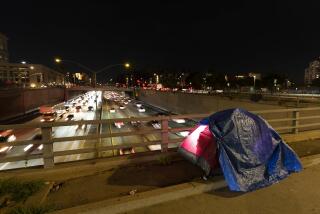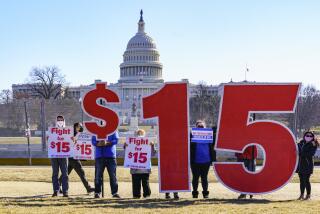Census Bureau Says 1 in 7 Are Now Living in Poverty
WASHINGTON — Fueled by a year-long recession, poverty expanded nationwide last year to include an estimated 33.6 million persons, an increase of 2.1 million over the previous year, Census Bureau officials said Thursday.
Nearly one person in seven--13.5% of the population--was living below the poverty line, officials said.
In California, the poverty total rose even faster, reaching 13.9%--or 4.2 million people--illustrating the extent to which the recession has engulfed the usually prosperous state, the census experts said. In 1989, 12.9% of the state’s residents lived in poverty.
Blacks, children, the elderly and Southerners were more likely to be among the nation’s poor than other groups, the bureau found.
Daniel Weinberg, the Census Bureau’s head of household economic statistics, called the national estimates a “significant increase.” He cautioned against placing too much faith in state figures, however, because of the small number of households surveyed in each state.
He said the figures were estimates based on interviews with 60,000 households earlier this year. The national poverty total of 13.5% compared to 12.8%, or 31.5 million people, in 1989.
The bureau bases its definition of poverty on annual income adjusted by the number of persons in the household, but it omits the value of property and some government assistance collected by family members. The official poverty line for an individual living alone is $6,652 and rises to $13,359 for a family of four.
Even before the Census Bureau released its findings, critics attacked the estimates as an inaccurate portrait.
At the Heritage Foundation, a Washington-based conservative think-tank, officials argued in news releases timed to coincide with the release of the bureau’s figures that the report “seriously misleads policy-makers and American taxpayers, who are spending over $180 billion a year to fight ‘poverty.’ ”
Heritage officials complained that the majority of the people identified by government economists as poor actually received government benefits, owned property and had assets such as homes, cars, air conditioners and microwave ovens--none of which are considered in the government estimates.
But other observers argued that the actual number of poor in America had been underestimated.
Robert Greenstein, director of the Center on Budget and Policy Priorities, a liberal research group in Washington, doubted the ability of the Census Bureau to accurately estimate the number of poor people.
“Whatever figures we hear (from government estimates) in 1990 will understate the degree of poverty in the country today,” he said.
Another study released Thursday, by the congressional Joint Economic Committee, noted that while the recession hurt all Americans, the poor suffered more. “Today the economy is in recession and many workers cannot find even a low-wage job,” said Sen. Paul S. Sarbanes (D-Md.), the committee chairman. “We face the very real danger that the poverty situation in the 1990s will not only repeat the 1980s, but could worsen significantly.”
Nevertheless, the bureau reported that of those Americans it found living in poverty, half were children and the elderly. Persons 18 and under accounted for 40% of the poor, while persons 64 and above added another 10.9%.
The bureau also found that 66.5% of the poor are white and that the South is the region with the highest poverty rate (15%) and the largest share of the poor (40.1%). The West has a poverty rate of 13%.
The poverty rate for blacks led all racial or ethnic groups with 32%, compared to 11% for whites, 28% for Latinos and 12% for Asians and Pacific Islanders.
The bureau also reported that Americans saw their paychecks shrink last year, as the average income of the nation’s households declined about $525 to $29,943, after adjusting for inflation. Similarly, individual income withered 3% to $14,387; it was the first such reduction in personal income since 1983.
Women continued to gain in earnings on men, as their average income remained flat from 1989 at $19,816, while men’s earnings dipped about 3.6% to $27,866.
Average household income for families living in metropolitan areas declined about 3% to $31,823, compared to non-metropolitan income of $23,709, which remained about the same as last year.
More to Read
Get the L.A. Times Politics newsletter
Deeply reported insights into legislation, politics and policy from Sacramento, Washington and beyond. In your inbox three times per week.
You may occasionally receive promotional content from the Los Angeles Times.










